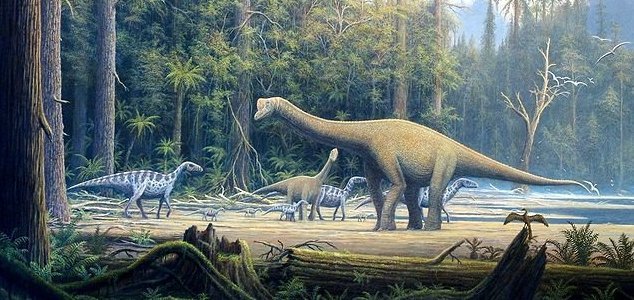Palaeontology
March 8, 2019 · 21 comments
21 comments

The dinosaurs may not have been in decline after all. Image Credit: CC BY-SA 2.5 Gerhard Boeggemann
Some have argued that the dinosaurs had already been in decline before the extinction, in particular due to changes in climate, competition with other species and a failure to speciate fast enough.
This, it is thought, may have made them particularly vulnerable to the apocalypse that followed.
Now though, a new study has cast doubt on this idea and has instead suggested that the very opposite was true - that the dinosaurs were in fact thriving before they were wiped out.
The research used ecological niche modelling to predict the environmental conditions suitable for various dinosaur species and where they might have thrived as the climate changed over time.
"The results of our study suggest that dinosaurs as a whole were adaptable animals, capable of coping with the environmental changes and climatic fluctuations that happened during the last few million years of the Late Cretaceous," said lead researcher Alessandro Chiarenza.
"Climate change over prolonged time scales did not cause a long-term decline of dinosaurs through the last stages of this period."
The findings open up the very real possibility that the dinosaurs may have never disappeared at all (and subsequently we may never have existed) if the asteroid strike hadn't occurred.
It seems that we may in fact owe our very existence to their untimely demise.
Source: UPI.com | Comments (21)
Dinosaurs were thriving before asteroid strike
By T.K. RandallMarch 8, 2019 ·
 21 comments
21 comments
The dinosaurs may not have been in decline after all. Image Credit: CC BY-SA 2.5 Gerhard Boeggemann
A new study has cast doubt on the idea that the dinosaurs had been in steady decline before the impact.
While it is generally accepted that the apocalyptic combination of a catastrophic asteroid strike and intense volcanism brought about the demise of the dinosaurs at the end of the Cretaceous, scientists have long struggled to agree on whether or not the prehistoric reptiles had been thriving beforehand.Some have argued that the dinosaurs had already been in decline before the extinction, in particular due to changes in climate, competition with other species and a failure to speciate fast enough.
This, it is thought, may have made them particularly vulnerable to the apocalypse that followed.
Now though, a new study has cast doubt on this idea and has instead suggested that the very opposite was true - that the dinosaurs were in fact thriving before they were wiped out.
"The results of our study suggest that dinosaurs as a whole were adaptable animals, capable of coping with the environmental changes and climatic fluctuations that happened during the last few million years of the Late Cretaceous," said lead researcher Alessandro Chiarenza.
"Climate change over prolonged time scales did not cause a long-term decline of dinosaurs through the last stages of this period."
The findings open up the very real possibility that the dinosaurs may have never disappeared at all (and subsequently we may never have existed) if the asteroid strike hadn't occurred.
It seems that we may in fact owe our very existence to their untimely demise.
Source: UPI.com | Comments (21)

The Unexplained Mysteries
Book of Weird News
AVAILABLE NOW
Take a walk on the weird side with this compilation of some of the weirdest stories ever to grace the pages of a newspaper.
Click here to learn more

Support us on Patreon
BONUS CONTENTFor less than the cost of a cup of coffee, you can gain access to a wide range of exclusive perks including our popular 'Lost Ghost Stories' series.
Click here to learn more
Israel, Palestine and the Middle-East
United States and the Americas
Science and Technology
Spirituality, Religion and Beliefs
Total Posts: 7,768,241 Topics: 325,020 Members: 203,763
Not a member yet ? Click here to join - registration is free and only takes a moment!
Not a member yet ? Click here to join - registration is free and only takes a moment!

































Please Login or Register to post a comment.